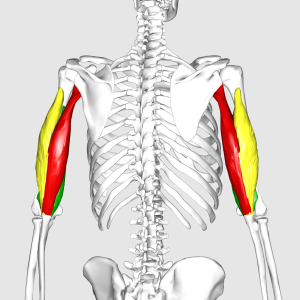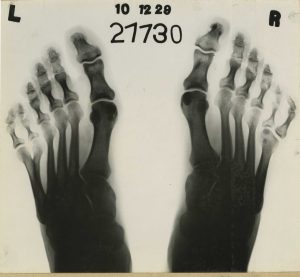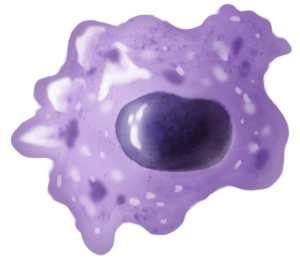3.4 Prefixes for Number and Size
Prefixes are often used to provide details concerning numbers and size. They provide added detail and specifics concerning the topic at hand. Although there are not many of these prefixes, they are still very important aspects of medical terminology. They will be discussed below with examples and practice questions to solidify your knowledge.
Table 3.18. Number Prefixes
| PREFIX | MEANING | EXAMPLE OF USE IN A MEDICAL TERM |
| nulli- | none | nulliparous |
| uni- | one | unilateral |
| bi- | two, both | bilateral |
| bin- | two | binocular |
| tri- | three | triceps |
| quadri- | four | quadriplegia |

Key Concepts
Numbers are often used in medical terminology, especially in the form of prefixes. For example, the terms unilateral and bilateral make it clear whether one side of the body or both sides are being discussed.
The triceps, shown in Fig. 3.20, is a large, thick muscle on the dorsal part of the upper arm. It often appears as a horseshoe shape on the posterior aspect of the arm, and the main function of the triceps is the extension of the elbow joint (Physiopedia, 2022). The prefix tri- (“three”) refers to the muscle’s three attachment points—the medial head, lateral head, and long head.
Table 3.19. Prefixes for Amounts
| PREFIX | MEANING | EXAMPLE OF USE IN A MEDICAL TERM |
| hemi- | half | hemiplegia |
| multi- | many | multipara |
| oligo- | few, very little | oliguria |
| pan- | all | pancytopenia |
| poly- | many, much | polydactyly |

Key Concept
When a baby is born with one or more extra fingers or toes, it is referred to as polydactyly (“pertaining to many digits”). It is a common condition, and approximately one out of every 500 to 1,000 babies is born with the condition (Boston’s Children’s Hospital, 2022). This is one of the most common congenital (“present at birth”) hand abnormalities and often runs in families.
Other medical terms with the prefix poly- are listed in Table 3.20 below.
Table 3.20. Examples of poly-
| MEDICAL TERM | MEANING |
|---|---|
| polydipsia | pertaining to much thirst |
| polydactyly | pertaining to many digits |
| polycystic | pertaining to many cysts |
| polymyositis | inflammation of many muscles |
| polyuria | pertaining to much urine |
| polyneuropathy | disease condition of many nerves |
| polyposis | state of many polyps |
Table 3.21. Prefixes for Size
| PREFIX | MEANING | EXAMPLE OF USE IN A MEDICAL TERM |
| macro- | large, long | macrophage |
| micro- | small | microscope |

Key Concept
A macrophage, shown in Fig. 3.22, is a type of white blood cell (WBC) that works by surrounding and killing microorganisms (National Cancer Institute, n.d.). It also removes dead cells and stimulates the action of other immune system cells.
Exercises
Attribution
Unless otherwise indicated, material on this page has been adapted from the following resource:
Carter, K., & Rutherford, M. (2020). Building a medical terminology foundation. eCampusOntario. https://ecampusontario.pressbooks.pub/medicalterminology/ licensed under CC BY 4.0
References
Boston Children’s Hospital. (2022). Polydactyly. https://www.childrenshospital.org/conditions/polydactyly
National Cancer Institute. (n.d.). Macrophage. https://www.cancer.gov/publications/dictionaries/cancer-terms/def/macrophage
Physiopedia. (2022). Triceps brachii. https://www.physio-pedia.com/Triceps_brachii
Image Credits (images are listed in order of appearance)
Triceps brachii muscle07 by Anatomography, CC BY-SA 2.1 Japan
X-ray of polydactyl feet (Reeve 48693), National Museum of Health and Medicine (3298021231) by National Museum of Health and Medicine, CC BY 2.0
Giemsa Stain Macrophage Illustration by Noah Smith, CC BY-SA 4.0
No birth; a women who has never given birth
Pertaining to one side
Pertaining to two (or both) sides
Pertaining to two eyes
An arm muscle with three attachment points (lateral, medial, and long) that joins the humerus and scapula to the ulna
Paralysis of all four extremities
Paralysis of half the body, usually caused by a cerebrovascular accident (stroke)
Many births; refers to a woman who has had two or more live births
Very little urine; this condition is characterized by below-normal output of urine of approximately 300 to 500 mL per day
Deficiency in all blood cells (red blood cells, white blood cells, and platelets)
Pertaining to many digits
A type of large white blood cell that surrounds and kills microorganisms, removes dead cells, and stimulates other immune system cells
An optical instrument used to view small particles by magnifying the particles

